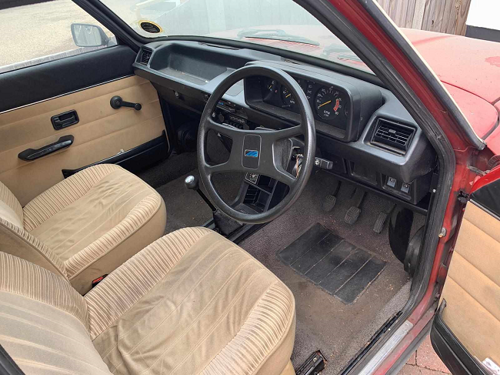MEET THE OWNER – MICHAEL FORMAN AND HIS AUSTIN ALLEGRO 1.3 HLS SERIES 3
22 April 2025
When I was (a lot) younger, an Allegro Series 3 such as Michael’s would have greatly intrigued me. It was not only the front air dam – which BL claimed improved fuel economy by 11% – the redesigned instruments or the improved equipment levels. No, when the S3 debuted in late 1979, its most notable feature, at least from my nine-year-old self’s perspective, was the HL version’s quad headlamps.

From a 2025 perspective, the four headlamps and front spoiler go quite a long way to enhancing the Allegro’s looks, and its cabin is wonderfully early 1980s. From BL’s perspective, it would help to maintain buyers’ interest until production ended in 1982. For many years, the Allegro was the only front-wheel-drive UK-built car in its class, but dealers now faced the challenge of the equally new Vauxhall Astra. Meanwhile, the Ford Escort Mk. III was scheduled for a 1980 launch.
Other rivals included the Anglo-French Talbot Horizon, which never really lived up to early commercial hopes in this country; the same problem afflicted the Renault 14. By contrast, the VW Golf was long established with British motorists, and the Citroën GSA’s roots dated back to 1970. Meanwhile, from Italy, the more recent Fiat Strada was already making a name for itself.
Keith Adams, the eminent motoring historian, argues on www.aronline.co.uk that:
The result was a pleasant-to-drive Allegro, all models were well-equipped and well-and-truly sorted: in other words, it developed into a capable car. If nothing else, the competence of the Allegro 3 proved the Development Engineers at BL had earned their money.
However, many Allegro owners argue it was always a capable vehicle, despite the mythology, and that in 1979 it was the UK’s fifth best-selling car.
By then, Leyland was still commissioning high-profile advertisements for the Allegro, even if this gem is one of the worst car commercials in the history of ITV:
Apparently, the advertising agency had requested a blue example from BL, only to be provided with a red model. Further calls resulted in a blue dealer demonstrator with a high mileage.
Such a story tends to illustrate the S3’s main challenge, which was British Leyland’s negative image due to their lack of quality control. If the Allegro was no longer in its first flush of youth by 1979, nor was the Golf, while the GSA was approaching its tenth birthday. Autocar was not especially taken with the Allegro’s handling but found it “very spacious” and “comfortable enough” – qualities most potential buyers required.

S3 production ended a year before BL unveiled its Austin Maestro successor. Michael came across his 1.3 HLS:
As part of an estate clearance and I did all the work myself at home as they are easy cars to work on. It had one owner from new, covered just 29,000 miles and sat in a garage untouched for 10 years. It took a year to recommission and, mechanically, the Allegro is very easy to work on and find parts for. It rides well and is spacious inside. The gear change is ponderous but the 1.3A+ engine pulls well; my Allegro is not a motorway express but feels cosy at 65-mph.
Today, his S3 looks highly appealing and is a reminder of how Leyland/Top Gear Jokes are the epitome of tedium. And after more than four decades, the
Allegro still has plenty of “Supervroom”. Just ask the Owners’ Club: http://www.allegroclubint.org.uk/
With thanks to Michael Forman for his time and permission to use the images in this blog.
